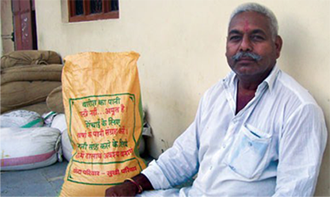Many areas that experience drought, also have excessive rainfall during the rainy season.
If the rain is saved, it can provide enough water to irrigate a farmer’s land throughout the dry season.
Capturing this water and storing it as surface water is called rainwater harvesting. By conserving the monsoon rain, farmers can increase the area they irrigate, grow crops in the dry season, support livestock and even recharge groundwater. This means better food provision for their families and higher incomes.
Stored rainwater also provides families with water for their household needs.
Ex-situ, or decentralized, rainwater harvesting refers to any structures built to capture rain. These could be ponds, tanks, or reservoirs and can be owned individually or communally. They are all shapes and sizes, depending on the amount of rainfall and the size of land available, the suitability of the location and above all, the needs of the farmer.
Some farmers manage to fund the building of their own pond, others need financial help.
There are other practices which help conserve the rain as it falls in the field. Building bunds or terraces increases the moisture retention of the soil and keeps rainwater where it is needed, around the crops. This is known as in-situ rainwater harvesting.
Ex-situ rainwater harvesting
In one area of Madhya Pradesh, the Collector had a dream. It was a simple idea but within a year it had proved to be very effective. He suggested farmers give over a tenth of their land to build a pond which would capture the water in the rainy season and save it for the dry one.
Those who took up the plan benefitted almost immediately. Now they can grow crops in both seasons and are seeing good returns for their investment.
Such schemes are arising all over India but many farmers are reluctant to develop ponds on their precious land and cannot afford the structure.
Farmers need financial and technical support to overcome these hurdles.
In West Bengal the Mahatma Ghandi National Rural Employment Guarantee Scheme (MGNREGS) is being used to build hapas – small reservoirs to store rainwater. These have contributed to increased livelihoods.
Rainwater Harvesting West Bengal – Hapas
Watershed Management – Ethopia
In-situ rainwater harvesting
Conservation agriculture (CA) is the term used to cover a variety of farming techniques which conserve rainwater in the soil. This improves the soil structure and moisture levels, which reduces the need for fertilisers and irrigation. As a result, yields and profits go up.
In situ rainwater harvesting is important for staple crops and offers protection in low-rainfall years.
But farmers are often put off because these techniques can be labor intensive and because they lack the necessary capital and training.

How To Support
Identify suitable areas – rainwater harvesting is likely to be more successful in those regions where there is high rainfall in parts of the year and sloping lands.
Show farmers the benefits – of building their own tanks and give them the relevant information.
Garner the support of the district administration – A responsive, understanding, and supportive local level bureaucracy is absolutely essential.
Provide access to loan capital.
Offer an appropriate subsidy – To partially compensate the farmers for the high cost of building water harvesting structures the government subsidy should be increased and made easily available.
Provide technical support – Such as engineering expertise and construction advice.
Decentralized Rainwater Harvesting
Where to Invest
Regional Analysis – Ex-Situ Rainwater Harvesting
Regional Analysis – In –Situ Rainwater Harvesting
West Bengal – Country Investments Brief
Madhya Pradesh – Country Investments Brief
Tanzania – Country Investments Brief
Zambia – Country Investments Brief
 Success Story
Success Story
Raghunath Singh Tomar of Harnavda village in Madhya Pradesh’s Dewas district had to single-handedly construct a one-hectare (ha), two-metre deep pond to irrigate his farm. His brother was not ready to help; he thought the irrigation model was a waste of time. In a year the pond irrigated 15 bighas (approximately 6 ha).







